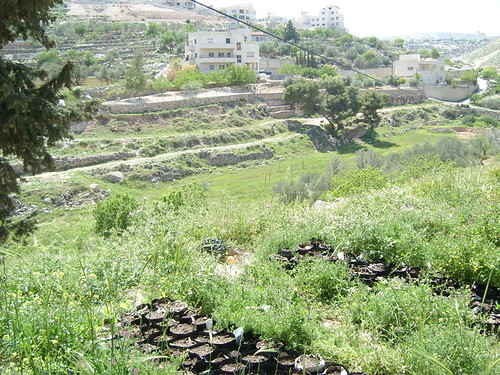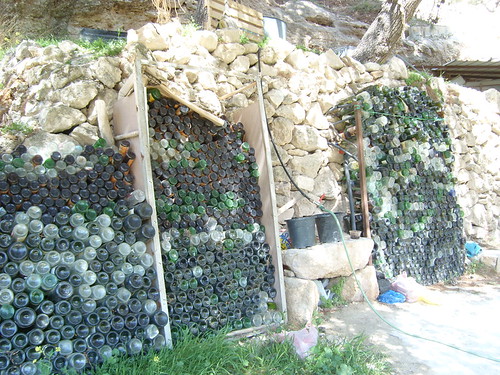By Nora Barrows-Friedman
"Back in my hometown of Berkeley, California, the practice of permaculture is associated within a feel-good, hippie-elite framework. It's a choice, just like buying locally grown organic heirloom tomatoes from an independent grocer instead of buying conventional Chilean-grown tomatoes hawked at Safeway. But inside the occupied West Bank, permaculture is not just a decision of conscience but a necessary means of empowerment within an ever-changing, uncertain landscape.
The reasons for this earth-friendly approach include accelerated loss of water-rich land to Israeli settlements, and Israeli restrictions on certain types of fertilizer and restrictions on what types of vegetables can be exported out of the occupied-territories. Out of creative necessity for food security, Palestinians have begun to re-green the land; reclaiming the ancient ways of growing crops.
Palestinians in the area say they are excited to participate in this burgeoning permaculture movement. "I was born here," Munther Rishmawi, a Beit Sahour resident says. "My grandfather farmed here on this same ground. And I'm learning to be a farmer in a new way...in Palestine, we don't have a lot. We just have land."
Alice Harrison, an environmental scientist from the United Kingdom, came to Palestine as a tourist and was moved by the humanitarian and environmental fallout from the Israeli occupation. She helped start the Bustan Qaraaqa farm last year after working on water development at a Palestinian NGO. "We were writing these reports about the environment being destroyed," Harrison says. "From the top-down development level, nothing was happening to prevent the destruction of Palestine. So, instead of saying this is terrible, something must be done, we thought, this is terrible, what do we do now?"
Harrison says the practice of permaculture in Palestine is multi-faceted. "We're developing simple things that anyone can do in order to salvage something from the occupation...We're also responding to the economic crisis and the food security crisis."
Farmers at Bustan Qaraaqa say that over 70 different species of native plants are being propagated and rooted throughout this wadi (Arabic for desert valley). Tiny sprigs of ricinus and pale green thyme reach for the sky in their little pots made from the bottoms of plastic juice bottles. Sage and mint grow in soil-filled car tires, and almond and apricot saplings nurture wildflowers at the base of their skinny trunks. Permaculture is not a tidy, clean-cut way of farming. Instead, plants and trees are packed in all together, grouped by need for certain nutrients, sun or shade, The term "weeds" does not apply; permaculture insists that every plant has its place and can offer something beneficial to the landscape. In the nursery at Bustan Qaraaqa, long, thick blades of wild grass protect new sprouts from the blazing sun.
Across the Green Line, Israeli agri-business flourishes and Israelis enjoy unrestricted access to land and water resources. Water grids and sophisticated irrigation provide an abundance of crops and full swimming pools during the summer. Even illegal Israeli settlements in the West Bank enjoy these privileges, while Palestinians in surrounding villages and refugee camps struggle with a fraction of the water supply.
According to a report published this week by the World Bank, the average Israeli receives access to four times as much water as the average Palestinian, resulting in what it calls a "near catastrophe" for the Palestinian Authority's current water system.
The green fields of vegetable and fruit crops in Israel are fed from water aquifers and the Jordan river as settlements across the West Bank are deliberately placed on top of the most fertile land and the biggest underground water tables. On the other hand, Palestinian farms, villages, towns and refugee camps (all of which are restricted from accessing the same water tables and the Jordan river) must then rely on rainwater-catching tubs on top of roofs and beside homes -- a meager source of water especially in the hot summer months.
Bustan Qaraaqa addresses this water crisis head-on. Volunteers are building a massive cistern on the southern edge of the property that will catch and reserve rainwater to be used for irrigation and fish farming; schools of tilapia will be introduced both as a form of mosquito control and as a source of food for the community.
"Palestine could lead the world in arid-zone agriculture," says Alice Harrison. "Already, 80% of the farming is rain-fed. It's a sustainable set-up to begin with -- but, it's predicted that, because of global climate change, rainfall in this area will decrease 20% by 2050. We should be prepared for it."











